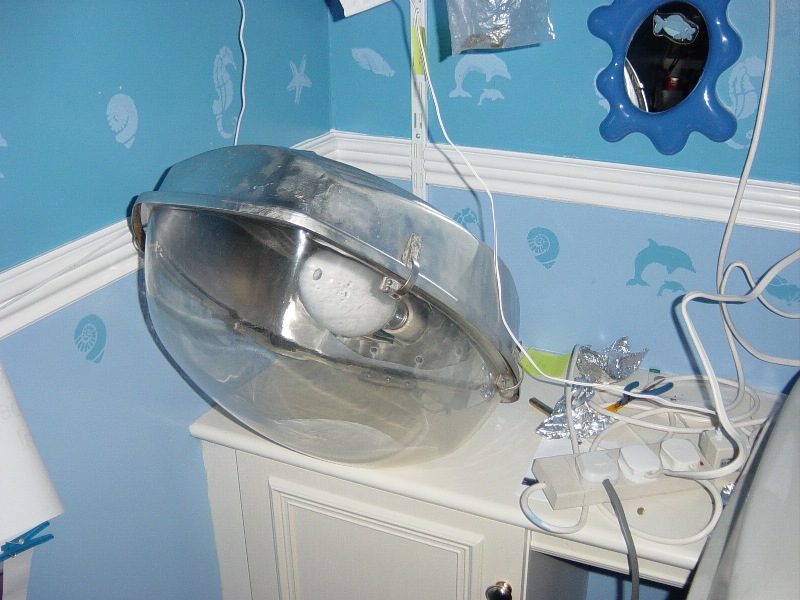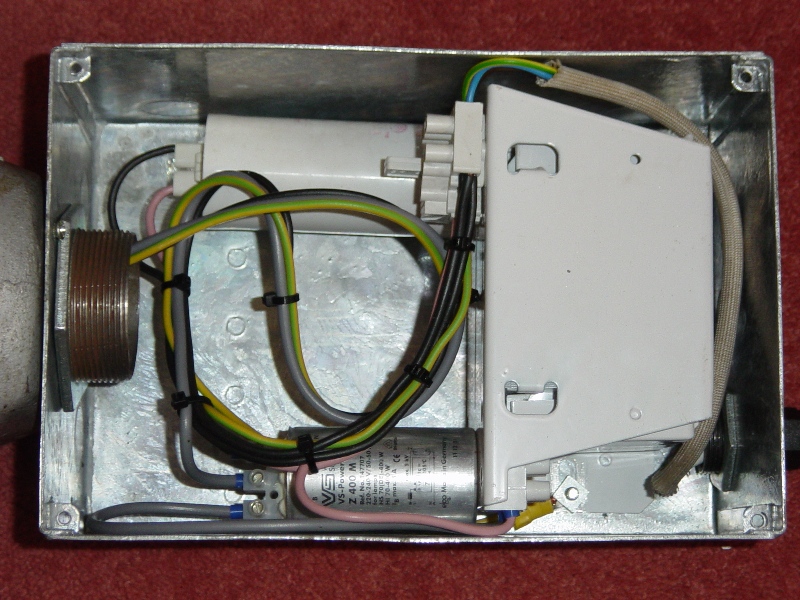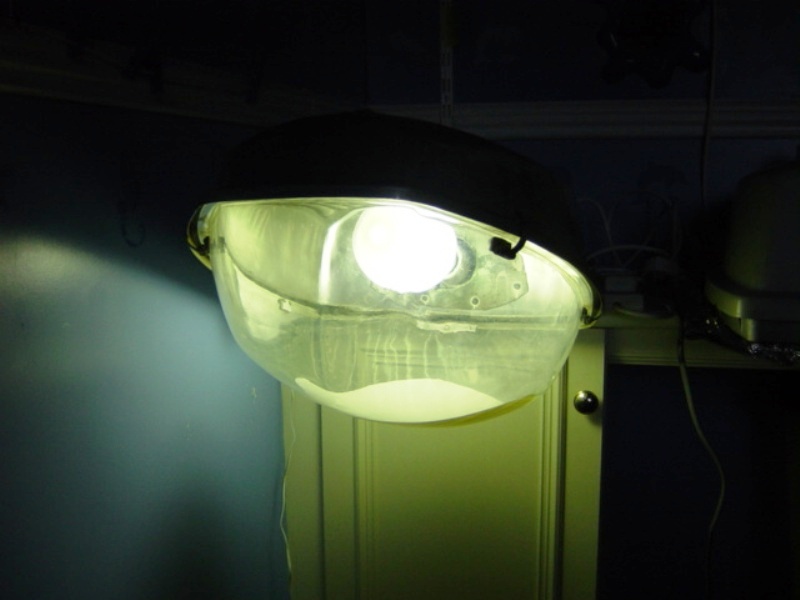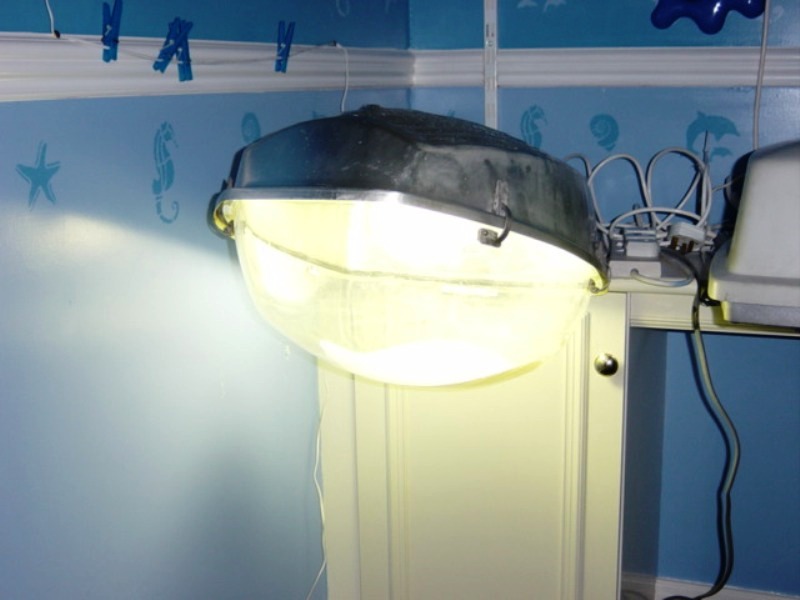Atlas Alpha 3
Lantern acquired in May 2003.
The lantern has never been used as a 'street' light - instead, it and three other Alpha 3s were used to light the so-called 'tram sheds' at Derby City Council's Stores Road depot (where I completed a week's work experience in May 2003). They were made redundant when new SON floodlights were installed. During my work experience, I mentioned to Jeremy that I was after an Alpha 3, and he mentioned the tram shed examples. Initially, he attempted to rescue one last-thing on the Friday of work experience, but by then, the sheds were locked; however, he tried again the following Monday (19th May) and was successful; bringing both the lantern, and a fresh lamp, around to me on the same day. The lamp control gear was situated in a box attached below the lantern's wall bracket, but was found to be too rusty to remove.
Despite never being used outdoors, the lantern was very dirty from the dank and dusty conditions in the tram sheds. The lantern is shown here at a very unusual angle - this is simply because of the depth of the bowl holding it up. The white diffusing spot on the bowl can just be seen. It is quite worn, and so I will repaint it at a later date.
Even though this is the gear in base version, the lantern still takes up quite a bit of space and it only just fitted on my desk.
By the lampholder, the remains of the identification label can just be seen. The top line of writing gives the name 'Alpha Three'; however, the lantern's alternative AEI name, the Optispec One, is also provided on the bottom line.
Owing to advanced degradation of this label, I cannot be certain as to whether it was branded as a late Atlas model, or an early Thorn, given that my Beta 8, 1970 Beta 5 and Beta 6 all include references to the AEI equivalent product name, and use labels (resembling the style of this one) that incorporate a Thorn logo. This label makes reference to the Atlas-style product code PNE.1400/S, however, when the equivalent Thorn product code was QA3.S.1400. Thus, the lantern was probably made during the transition period of the late 1960s, and therefore, could even be branded as a BLI (British Lighting Industries) product.
Restoring the reflector spot.
These three photographs show how the reflector spot on the bowl was restored - as mentioned above, it was starting to wear off in places (if you rubbed your finger over it, you'd end up with a cream fingertip!); however, I left the original Atlas spray painted spot on as a guide and then stuck short lengths of masking tape around it. The second photograph shows the repainted spot, still with the tape in place, and the third: the finished and cleaned spot. It's about 1 mm wider than before, and the edges look a bit jagged, but I think that it looks a lot better.
Restoring the canopy and casting.
The canopy half-way through cleaning. There are still many spots of dirt on it, and the casting. Also, the canopy's sides are still of a matte finish.
The restored canopy and casting - much shinier than it appeared in the above photograph! Almost all of the dirt was removed, although some specks remained - these had probably burnt into the aluminium from the years of heating by the lamp, as they couldn't be removed.
The restored canopy's insides. I managed to get most of the blackening from the metal, particularly in the middle and front sections. I've not been able to remove it from the sides as successfully, however.

The complete lantern (with a lamp this time!) after I finished the restoration.
To clean the canopy and the casting, I used a special soap called 'Exodus' firstly, followed by rubbing it with a 'Brillo' soap pad, and finally being wiped with a cloth dipped in warm soapy water.
By popular request, I've put the Alpha 1 next to the Alpha 3 to show off how the two castings are different - the Alpha 1's has curved edges and is narrower, but the Alpha 3's has straighter edges and is wider.
The Finished Lantern

The Alpha 3's gear - in a metal box (I was worried the heat might melt a plastic one!). The components are: (in a clockwise direction) the capacitor, ballast and ignitor. An ignitor is connected as the gear is actually meant for metal halide lamps, but this will be removed at some point [see below].

Once the lamp had fully warmed up, my room was very well (if not slightly too well!) lit. The reflector spot didn't really make a great deal of difference, so this is probably why the later Alpha 3s had refractor lines moulded into the bowl instead.

This time, I tried using the flash...only to find that now hardly any light output can be seen at all! You can't win!
Lantern warm-up video:
The lantern was mounted to an AC Ford AC872 wall bracket on Tuesday, 9th August 2005. The gear box was removed and proper mercury gear was mounted remote from the lantern. The metal halide gear will be kept for spares. The side of the Thorn EMI Alpha 3 can be seen to the left of the picture.
Both Alpha 3s are shown below, however - as the photograph shows, there are few differences between the old and the new versions.
Testing with my energy monitoring device revealed the following results:
| Test Voltage (V) | Current being drawn at full power (A) | Measured wattage (W) | Apparent Power (VA) | Frequency (Hz) | Power Factor | True Power (W) | Difference to rated wattage | Percentage Difference |
| 237.1 | 2.36 | 465 | 560 | 49.7 | 0.83 | 464.43 | 64.43 | 16% |
|
Alpha 3 Lanterns in the Collection |
||
| Atlas (Modified
Type)
|
Thorn EMI | |
CLICK HERE TO MAKE A MONETARY DONATION
© 2002 - English Street Lights Online